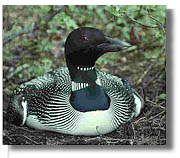Common Loon Gavia immer
 A
very large duck measured at 28 to 35 inches. During the breeding period in mid-March
to late-April, Common Loons will have a checkered black and white pattern on their backs
until their wintering moult (shed of feathers). Their heads are inky-black with red
eyes and a sooty sharp bill. The throat and neck have a horizontal checkered
stripe. Their breast is snowy white. Wintering and immature colours are duller
than breeding colours, with no checkered back pattern. The call of the Common Loon is
loud and laugh-like, during the breeding season. Heavy solid bones allow this loon
to dive deep in pursuit of fish. A behavioural trait is the clumsy way the loon tries
to travel on land, inhibited by the structure of its feet. During its breeding time
it may be found inland, in rivers, sheltered bays and tidal channels. There are strong
indications, however, that nests are only to be found on islands with mixed wood
stands. Eggs may be found on an island beach. After one to three eggs are
hatched in late July, the loon's young will be escorted to the mainland. The
southern horizontal breeding limit for this animal lies within the Maritimes. This
bird breeds mainly in Canada and Alaska, and winters all along the North American western
and eastern coastlines. Studies are underway to determine how the population of the
Common Loon may be affected by mercury.
A
very large duck measured at 28 to 35 inches. During the breeding period in mid-March
to late-April, Common Loons will have a checkered black and white pattern on their backs
until their wintering moult (shed of feathers). Their heads are inky-black with red
eyes and a sooty sharp bill. The throat and neck have a horizontal checkered
stripe. Their breast is snowy white. Wintering and immature colours are duller
than breeding colours, with no checkered back pattern. The call of the Common Loon is
loud and laugh-like, during the breeding season. Heavy solid bones allow this loon
to dive deep in pursuit of fish. A behavioural trait is the clumsy way the loon tries
to travel on land, inhibited by the structure of its feet. During its breeding time
it may be found inland, in rivers, sheltered bays and tidal channels. There are strong
indications, however, that nests are only to be found on islands with mixed wood
stands. Eggs may be found on an island beach. After one to three eggs are
hatched in late July, the loon's young will be escorted to the mainland. The
southern horizontal breeding limit for this animal lies within the Maritimes. This
bird breeds mainly in Canada and Alaska, and winters all along the North American western
and eastern coastlines. Studies are underway to determine how the population of the
Common Loon may be affected by mercury.
Pied-bill Grebe Podilymbus podiceps
A medium-sized bird, at 12 to 15 inches in length, the Pied-bill Grebe is
box-like in structure, mostly brown to black in colour. When breeding, Pied-bill
Grebes will have a black-ringed throat. Juveniles and breeding adults have a
black-ringed bill. The National Audubon Society defines the Pied-Bill Grebe's call
as a "a low, hollow series of cow-oo, cow-oo notes." Due to the
Grebe's short beak, and awkward land travelling the Grebe's chief food source is aquatic
vegetation. These birds are commonly found in what the Museum of Natural History
classifies as Deep and Shallow Marshes, a sub-classification of Wetlands. Nests are found on floating, anchored rafts of dead vegetation near or surrounded
by aquatic plant growth. The nest may contain four or nine eggs, laid between late May
to late June. Wintering areas include the Great
Lakes and the United States coastline marshlands. A habit of this bird is to
quietly submerge itself until only its head is showing above water. This behaviour
has also been attributed to other duck species, so it should not be solely used to
identify the Pied-billed Grebe.
Great Blue Heron Ardea herodius
A large bird with a long beak, long legs, and extended, tightly curled neck.
 Abdomen
or back is blue-white, with blue markings between eyes and beak, and capping the
head. The blue cap is divided by a central white streak, starting from the
beak. Sometime during its growth or breeding phase, this heron may be entirely
white. Size is 39 to 52 inches or four feet tall. Wingspan may be as wide as
seven feet. The Great Blue Heron's call is an infrequent grunt. An expert
fisher, this heron will be found around interior bodies of water, marshlands and bogs,
hunting for frogs or fish in a shallow channel. It will not be found in a
mountainous region. This bird mainly winters in the eastern two-thirds of the United
states. There are only four Canadian areas where the Great Blue Heron may be
found: In most of the Maritimes, possibly excluding Newfoundland, the Great Lakes,
central Canada, and the western coastline of British Colombia. Wintering range also
includes the British Columbia coastline and the southern half of the United States.
The Great Blue Herons have tried to extend their wintering range to include Nova Scotia
but were unsuccessful. Usually this bird arrives in late March to breed until early
August. Eggs are commonly located high in mixed stands near an inland body of
water. The Great Blue Heron's nests may contain four to seven eggs laid from
mid-April to late May.
Abdomen
or back is blue-white, with blue markings between eyes and beak, and capping the
head. The blue cap is divided by a central white streak, starting from the
beak. Sometime during its growth or breeding phase, this heron may be entirely
white. Size is 39 to 52 inches or four feet tall. Wingspan may be as wide as
seven feet. The Great Blue Heron's call is an infrequent grunt. An expert
fisher, this heron will be found around interior bodies of water, marshlands and bogs,
hunting for frogs or fish in a shallow channel. It will not be found in a
mountainous region. This bird mainly winters in the eastern two-thirds of the United
states. There are only four Canadian areas where the Great Blue Heron may be
found: In most of the Maritimes, possibly excluding Newfoundland, the Great Lakes,
central Canada, and the western coastline of British Colombia. Wintering range also
includes the British Columbia coastline and the southern half of the United States.
The Great Blue Herons have tried to extend their wintering range to include Nova Scotia
but were unsuccessful. Usually this bird arrives in late March to breed until early
August. Eggs are commonly located high in mixed stands near an inland body of
water. The Great Blue Heron's nests may contain four to seven eggs laid from
mid-April to late May.
Double-crested Cormorant Phalacrocorax auritus
Mature Double-crested Cormorants are between 30 to 36 inches in size. Colour is black overall, with a patch of orange below and above the eyes. The
beak is long, with a hooked end. This Cormorant gets its name from the two black
tufts bracketing its cap. Immature cormorants are mainly brown, and their underbodies
are a paler hue of brown. A trait possibly unique to this bird is
the habitually motionless spread of wings to dry them in the sun. They are similar
to the Common Loon in that they are heavy-boned diving birds that require some running
distance to fly. A rather quiet bird, it only grunts when near its nest.
Nests are found in clusters on cliff ledges near the sea, or in high trees on
islands. A nest may contain three to six eggs. Laying period is between late
April and late May. Breeding migration patterns include the North American
coastlines, central Canada, the Great Lakes, and South America. Wintering range
includes the southeastern coastline of the United States and the entire western coastline,
from Alaska to southern United States. Expect to see this bird by mid-April to late
May. Peak wintering migrations occur between mid-September and late October.
A trait possibly unique to this bird is
the habitually motionless spread of wings to dry them in the sun. They are similar
to the Common Loon in that they are heavy-boned diving birds that require some running
distance to fly. A rather quiet bird, it only grunts when near its nest.
Nests are found in clusters on cliff ledges near the sea, or in high trees on
islands. A nest may contain three to six eggs. Laying period is between late
April and late May. Breeding migration patterns include the North American
coastlines, central Canada, the Great Lakes, and South America. Wintering range
includes the southeastern coastline of the United States and the entire western coastline,
from Alaska to southern United States. Expect to see this bird by mid-April to late
May. Peak wintering migrations occur between mid-September and late October.




